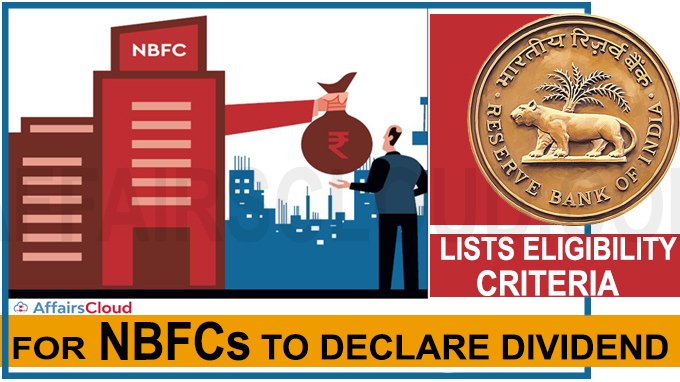 The Reserve Bank of India (RBI) in its recent 4th Bi-Monthly Monetary Policy Committee (MPC) 2020-21 announced to issue guidelines for Non-Banking Financial Companies (NBFCs) with regard to distribution of dividend. Therefore on December 9, 2020, the apex bank released the “Draft Circular on Declaration of Dividend by NBFCs” to ensure greater transparency and uniformity in practice. It is open for comments by December 24, 2020.
The Reserve Bank of India (RBI) in its recent 4th Bi-Monthly Monetary Policy Committee (MPC) 2020-21 announced to issue guidelines for Non-Banking Financial Companies (NBFCs) with regard to distribution of dividend. Therefore on December 9, 2020, the apex bank released the “Draft Circular on Declaration of Dividend by NBFCs” to ensure greater transparency and uniformity in practice. It is open for comments by December 24, 2020.
- The guidelines will be applicable for dividends to be declared for the financial year beginning April 01, 2020 (FY 2020-21) onwards.
Following are the Key Features of Draft Circular:
Eligibility: The NBFCs are required to comply with the following minimum prudential requirements in order to declare dividend:
i.NBFCs should comply with the provisions of Section 45 IC of the RBI Act, 1934.
ii.The proposed dividend should be payable only out of the current year’s profit.
iii.Capital Adequacy and Leverage:
- Deposit taking NBFC (NBFC-D) and Systemically Important Non-Deposit taking NBFC (NBFC-ND-SI) should have capital-to-risk weighted assets ratio (CRAR) or capital adequacy ratio of at least 15% for the last 3 years.
- Non-Systemically Important Non-Deposit taking NBFC (NBFC-ND) should have leverage ratio of less than 7 for the last 3 years.
- Core Investment Company (CIC) should have Adjusted Net Worth (ANW) of at least 30% of its aggregate risk weighted assets on balance sheet and risk adjusted value of off-balance sheet items for the last 3 years.
iv.Non-Performing Assets (NPA):
- The net NPA ratio should be less than 6% in each of the last 3 years.
It should be noted that in all of the above eligibility criteria the last 3 years should include the accounting year for which dividend is to be declared.
What is CRAR?
It considers the ratio of risk-weighted assets (mainly loans) to capital. It is used to protect depositors by measuring the financial strength of the company.
What is Leverage Ratio?
It used to measure a company’s capital structure, financial obligations and its ability to clear those obligations. There are different leverage ratios viz.
- Debt to Equity = Total debt / Shareholders Equity
- Debt to Capital = Total debt / Capital (debt+equity)
- Debt to Assets = Total debt / Assets
Key Points:
–Dividend pay-out ratio should be calculated as a percentage of ‘dividend payable in a year’ to ‘net profit during the year’.
–Standalone Primary Dealers (SPDs) having CRAR at 20% or above during all the four quarters of the accounting year in which dividend is proposed, should not exceed the dividend pay-out ratio from 60%.
–In accordance with the CRAR and net NPA, the DPR (the amount of dividends paid in relation to the total amount of net income a company generates) can maximum be 50% in the case of NBFC-D and NBFC-ND-SI.
–NBFC should submit a copy of guidelines before it’s Board at its next meeting in order to make decisions on the proposals which should be in the interest of all stakeholders.
–NBFC-D, NBFC-ND-SI & CICs declaring dividend should report details of dividend declared during the accounting year to their relevant Regional Office of the Department of Supervision of the Bank.
Recent Related News:
i.On November 5, 2020, the RBI has revised the loan scheme of the Co-origination Model between Banks and NBFC-ND-Sis launched in September 2018 with the improved “Co-Lending Model (CLM)”. The Scheme CLM helps banks to provide loans along with NBFCs including HFCs (Housing Finance Companies) for priority sector borrowers based on a prior agreement.
ii.On November 16, 2020, two sandbox entities viz. Natural Support Consultancy Services Pvt.Ltd. of Jaipur, Rajasthan and Nucleus Software Exports Ltd. of New Delhi have started the first test phase of their products viz. “eRupaya” and “PaySe” respectively under the RBI’s under the Regulatory Sandbox (RS) with “Retail Payments”, as its theme.
About Reserve Bank of India (RBI):
Formation– 1 April 1935
Governor– Shaktikanta Das
Headquarters– Mumbai, Maharashtra
Deputy Governors– 4 (Bibhu Prasad Kanungo, Mahesh Kumar Jain, Michael Debabrata Patra, and M Rajeswar Rao)




